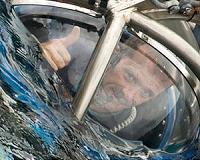 |
Cape Canveral FL (SPX) Sep 02, 2010 The Italian-built multi-purpose logistics module (MPLM) called Leonardo was built to serve the same purpose as its two brothers, Rafaello and Donatello: to ferry supplies, equipment, experiments and other cargo to and from the International Space Station via the space shuttle's payload bay. Now the module formerly known as Leonardo is on its way to a permanent assignment in space. An MPLM is designed to be carried to the space station by a shuttle, be temporarily attached to the station to allow astronauts to float inside and remove cargo and fill it back up with items, and then be detached and returned to Earth by the shuttle. "For many years, NASA and the Italian Space Agency have been looking at the potential of turning one of the multi-purpose logistics modules into a permanent module to fly and attach to the station and leave behind," says Scott Higginbotham, the payload mission manager for space shuttle Discovery's STS-133 flight. "Efforts to actually conduct the conversion got serious in the summer of 2009 when we started studies to understand specifically what modifications would be necessary to make the conversion from a temporary visiting vehicle to a permanent vehicle." Once the conversion plan was approved, the Italian Space Agency contracted with Thales Alenia Space, the European company that originally built the module, to perform the majority of the modifications. "There are three basic types of modifications that were performed to make the conversion from the MPLM to the PMM (Permanent Multipurpose Module)," explains Higginbotham. "The first has to do with weight. We tried to reduce the weight of the module as much as possible by eliminating hardware that we didn't need for the long-duration stay on orbit to allow us to carry more useful cargo up to space on STS-133." The second set of modifications was aimed at making the module's interior more user-friendly to the station crew members. "For example, we have modified some of the panels inside the vehicle so that they are much easier for the astronauts to open and close during a flight," says Higginbotham. But by far the biggest change was preparing the PMM to spend 10 years exposed to the rigors of space instead of the 10 days it might previously have been outside the protection of the shuttle during a mission. "Probably most significantly we had to armor the exterior of the module so that it can withstand the micrometeoroid and hypervelocity debris impacts over the 10 years that it'll be on the station," says Higginbotham, "Rather than modify the external shields, which are made of metal, which was going to be heavy and expensive, the clever idea that both we and the Italians came up with was to install a micrometeoroid mattress, which is basically a bullet-proof vest for the station that lies underneath the metallic shield and on top of the pressure vessel." When the modifications are completed, the module will be loaded with the STS-133 payload and fly aboard Discovery, remaining at the station at the end of the mission. The extra space it provides will give the station's resident crew what amounts to a giant new float-in closet to help store supplies, equipment and potentially experiments aboard the orbiting laboratory, helping the station continue its mission through the decade.
Share This Article With Planet Earth
Related Links John F. Kennedy Space Center Station at NASA Station and More at Roscosmos S.P. Korolev RSC Energia Watch NASA TV via Space.TV Space Station News at Space-Travel.Com
 Canadian to command space station in 2013
Canadian to command space station in 2013Ottawa (AFP) Sept 2, 2010 Astronaut Chris Hadfield in 2013 will become the first Canadian to command the International Space Station (ISS), the Canadian Space Agency announced Thursday. Hadfield, 51, will rocket on his third trip into space aboard a Russian Soyuz spacecraft in December 2012 and assume command of the station during the second part of a six-month mission. Over the first four months, as an ISS fligh ... read more |
|
| The content herein, unless otherwise known to be public domain, are Copyright 1995-2010 - SpaceDaily. AFP and UPI Wire Stories are copyright Agence France-Presse and United Press International. ESA Portal Reports are copyright European Space Agency. All NASA sourced material is public domain. Additional copyrights may apply in whole or part to other bona fide parties. Advertising does not imply endorsement,agreement or approval of any opinions, statements or information provided by SpaceDaily on any Web page published or hosted by SpaceDaily. Privacy Statement |